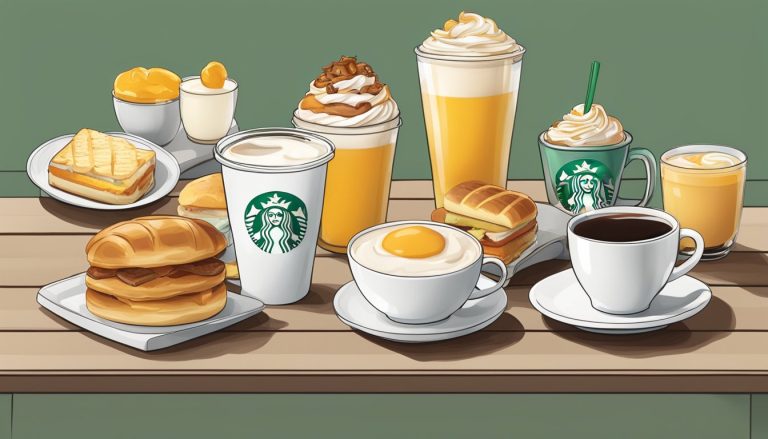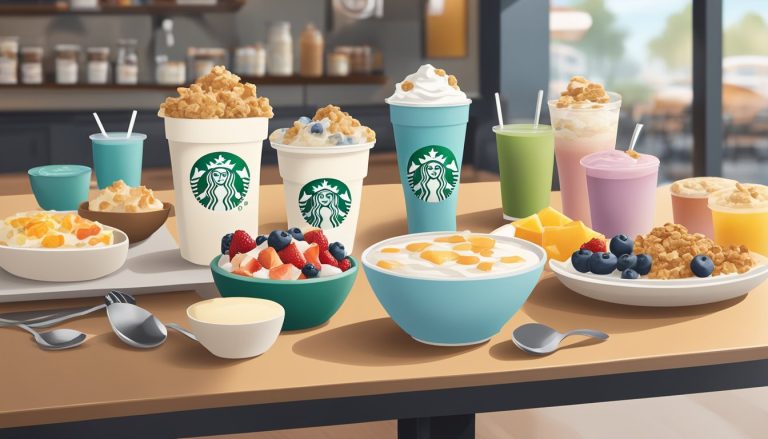Starbucks has revolutionized the coffee industry with its emphasis on customization, extending this approach to its breakfast menu. Customers can tailor their morning meals to suit their preferences, from adjusting ingredients to modifying portion sizes. This personalized approach has been a key driver of Starbucks’ growth, setting it apart from traditional fast-food chains and appealing to consumers who value individualized experiences.
The coffee giant’s breakfast offerings go beyond standard fare, incorporating a variety of options that cater to different tastes and dietary needs. From egg sandwiches to pastries, each item can be customized, allowing patrons to create their ideal morning meal. This level of flexibility not only enhances customer satisfaction but also encourages experimentation and repeat visits.
Starbucks’ commitment to customization in its breakfast menu reflects a broader trend in the food service industry. By giving customers control over their orders, the company has fostered a sense of loyalty and engagement. This strategy has proven particularly effective in the morning rush, when people are looking for quick, personalized options to start their day.
Starbucks’ Brand Identity and Coffee Culture

Starbucks has cultivated a distinct brand identity centered around creating a welcoming “third place” beyond home and work. This philosophy, combined with global expansion efforts, has shaped Starbucks into a cultural icon synonymous with premium coffee experiences worldwide.
The Philosophy of the ‘Third Place’
Starbucks embraces the concept of the “third place” – a comfortable space between home and work where people can relax, connect, and enjoy quality coffee. This idea permeates store designs, featuring cozy seating areas and warm lighting to foster a sense of community.
Baristas play a key role in this philosophy, trained to provide personalized service and remember regular customers’ orders. The emphasis on customization extends to beverages, with a wide array of options allowing patrons to create their perfect drink.
Music, free Wi-Fi, and local art displays further enhance the inviting atmosphere, encouraging customers to linger and making Starbucks a daily ritual for many.
Global Expansion and Local Community Engagement
Starbucks has successfully expanded globally while maintaining a connection to local communities. The company adapts its offerings to suit regional tastes, such as tea-based drinks in Asia or local pastries in Europe.
Store designs often incorporate elements of local architecture and culture, helping each location feel familiar yet distinct. Starbucks also engages in community initiatives, supporting local causes and sourcing from regional suppliers where possible.
This approach has allowed Starbucks to become a global brand with a local feel. The company’s commitment to ethical sourcing and sustainability further strengthens its ties to coffee-growing communities worldwide.
Customization as a Cornerstone of Starbucks’ Strategy

Starbucks has built its empire on offering personalized coffee experiences. The company’s focus on customization extends beyond beverages to its breakfast menu, setting it apart in a competitive market.
Customization Trend in the Coffee Industry
Starbucks pioneered the concept of customizable coffee drinks, revolutionizing the industry. Customers can modify their orders with various milk options, flavored syrups, and toppings. This trend has expanded to breakfast items, allowing patrons to tailor their meals.
For example, customers can request egg whites instead of whole eggs in breakfast sandwiches or add extra toppings to their oatmeal. This level of personalization creates a unique experience for each visitor, fostering brand loyalty.
Starbucks’ mobile app further enhances customization by allowing customers to save favorite orders and make modifications easily. This digital integration streamlines the ordering process while maintaining a high degree of personalization.
The Role of Baristas in Personalization
Baristas play a crucial role in Starbucks’ customization strategy. They are trained to engage with customers, remember preferences, and offer suggestions for personalized drinks and food pairings.
These skilled employees can craft complex custom orders with precision, ensuring consistency across visits. Baristas often develop relationships with regular customers, anticipating their preferences and creating a welcoming atmosphere.
Starbucks invests heavily in barista training, emphasizing product knowledge and customer service skills. This investment pays off in the form of satisfied customers who return for their perfectly crafted, personalized orders.
Strategic Partnerships and Operational Efficiency
To support its customization efforts, Starbucks forms strategic partnerships with suppliers and technology companies. These collaborations ensure a steady supply of diverse ingredients and cutting-edge ordering systems.
Partnerships with dairy alternatives providers, for instance, allow Starbucks to offer a wide range of milk options. Collaborations with food suppliers enable the company to source high-quality, customizable breakfast items.
Starbucks has also invested in efficient operations to handle complex custom orders without sacrificing speed. Advanced equipment and streamlined processes allow baristas to create personalized drinks quickly.
The company’s mobile ordering system reduces wait times for custom orders, improving operational efficiency. This technology balances personalization with speed, enhancing the overall customer experience.
Customer Experience and Engagement

Starbucks excels at creating memorable experiences and fostering customer loyalty through personalization and digital innovation. The company’s focus on emotional connections, convenient mobile ordering, and social media engagement has revolutionized how customers interact with the brand.
Creating an Emotional Connection with Customers
Starbucks aims to be more than just a coffee shop – it strives to be a “third place” between home and work. The company trains baristas to engage in friendly conversation and remember regular customers’ names and orders. This personal touch helps create a welcoming atmosphere.
Seasonal menu items and festive store decorations tap into customers’ emotions around holidays and changing seasons. Limited-time offerings like the Pumpkin Spice Latte generate excitement and a sense of urgency to visit.
Starbucks’ commitment to ethical sourcing and sustainability also resonates with socially-conscious consumers. By aligning with customers’ values, the brand forges deeper connections beyond just transactions.
Importance of Mobile Ordering and Customization Options
The Starbucks mobile app has transformed the customer experience through convenient ordering and payment options. Customers can customize drinks, order ahead, and skip the line – saving time during busy mornings.
The app’s rewards program incentivizes repeat visits and larger purchases. Members earn “stars” for each dollar spent, which can be redeemed for free items.
Drink customization is a core part of Starbucks’ appeal. The app allows customers to save favorite customized orders for easy reordering. This personalization caters to individual tastes and dietary needs.
Leveraging Social Media for Customer Engagement
Starbucks maintains an active presence across social media platforms to connect with customers. The brand shares behind-the-scenes content, highlights new menu items, and engages in two-way conversations with followers.
User-generated content is a key part of Starbucks’ strategy. The company encourages customers to share photos of their drinks, often reposting them to its own accounts. This creates a sense of community and social proof.
Social media also serves as a customer service channel. Starbucks responds promptly to inquiries and complaints, demonstrating its commitment to resolving issues and improving the customer experience.
Customization Options in the Breakfast Menu

Starbucks offers extensive customization options for its breakfast menu, allowing customers to tailor their morning experience. These choices span both beverages and food items, giving patrons the ability to create unique combinations.
Espresso and Coffee Drink Customizations
Coffee drinkers can modify their espresso and coffee beverages in numerous ways. Customers can select their preferred milk type, including dairy options like whole, skim, or 2%, as well as non-dairy alternatives such as soy, almond, or oat milk. The number of espresso shots can be adjusted to increase caffeine content or alter flavor intensity. Sweeteners are available in various forms, from classic sugar to sugar-free syrups.
Flavor additions include a wide array of syrups, with popular choices like vanilla, caramel, and hazelnut. Toppings such as whipped cream, cinnamon dolce sprinkles, or cocoa powder provide extra indulgence. Temperature preferences are also accommodated, with iced, hot, or extra hot options available for most drinks.
Custom Food Pairings with Beverage Choices
The breakfast menu allows for personalized food and drink combinations. Customers can pair their customized coffee with a range of breakfast items. Savory options include egg sandwiches with customizable bread choices, such as croissants or English muffins. For those with a sweet tooth, pastries like muffins or danishes can be selected.
Dietary restrictions are considered, with gluten-free and vegan items available. Portion sizes can often be adjusted, allowing customers to choose between full-sized items or smaller snacks. Some locations offer the option to add extra ingredients to breakfast sandwiches, such as additional cheese or vegetables, further enhancing the customization experience.
Quality and Sustainability Commitments

Starbucks prioritizes quality and sustainability throughout its operations. The company focuses on ethical sourcing practices for coffee beans and implements eco-friendly initiatives in its product offerings.
Sourcing Ethically Produced Coffee
Starbucks commits to purchasing coffee beans from responsible suppliers. The company works directly with farmers to ensure fair wages and sustainable farming practices. Starbucks has developed its own Coffee and Farmer Equity (C.A.F.E.) Practices, a set of guidelines for ethical sourcing.
These standards cover economic, social, and environmental criteria. Farmers who meet these requirements receive preferential pricing and contracts. Starbucks aims to source 100% of its coffee through C.A.F.E. Practices, Fairtrade, or other externally audited systems.
The company also invests in farmer support centers. These facilities provide training on sustainable farming techniques and help improve crop yields.
Sustainability Practices in Product Offerings
Starbucks incorporates sustainability into its menu items and packaging. The company has introduced plant-based milk alternatives to reduce its carbon footprint. These options include soy, almond, coconut, and oat milk.
Starbucks is working to develop more eco-friendly packaging solutions. The company aims to double the recycled content in its cups and make them fully recyclable. It has also launched reusable cup programs in some markets.
In stores, Starbucks implements energy-saving measures. These include LED lighting, energy-efficient appliances, and water conservation systems. The company has set a goal to reduce its carbon emissions by 50% by 2030.
Starbucks partners with organizations to promote sustainability. It collaborates with Conservation International to support coffee-growing communities and protect biodiversity in coffee regions.
Seasonal and Limited-Time Offerings

Starbucks leverages seasonal and limited-time offerings to create excitement and drive customer engagement. These special items tap into seasonal trends and customer preferences, enhancing the brand experience.
The Phenomenon of the Pumpkin Spice Latte
The Pumpkin Spice Latte has become a cultural icon and a significant driver of fall sales for Starbucks. Introduced in 2003, this seasonal drink combines espresso, steamed milk, and pumpkin spice flavoring.
Its annual return generates substantial buzz on social media and in the press. The limited availability creates a sense of urgency among customers, encouraging repeat visits during the fall season.
Starbucks has expanded the pumpkin spice product line to include cold brews, frappuccinos, and baked goods. This strategic move capitalizes on the flavor’s popularity and caters to diverse customer preferences.
Seasonal Flavors and the Influence on Brand Experience
Starbucks’ seasonal offerings extend beyond the Pumpkin Spice Latte. The company introduces holiday-themed drinks and pastries throughout the year, aligning with different seasons and celebrations.
These limited-time flavors include:
- Peppermint Mocha (winter)
- S’mores Frappuccino (summer)
- Maple Pecan Latte (fall)
Seasonal offerings create a sense of anticipation and novelty. They encourage customers to try new products and revisit the store more frequently.
The rotating menu keeps the brand fresh and relevant. It also allows Starbucks to test new flavor combinations and gauge customer reactions before potentially adding items to the permanent menu.
Technological Innovation and the Coffee Chain

Starbucks has embraced technology to enhance customization and streamline operations. The coffee chain’s digital initiatives have revolutionized how customers order and interact with the brand.
Role of Technology in Enhancing Customization
Starbucks’ mobile app stands at the forefront of its technological innovation. Launched in 2009, the app allows customers to order and pay for drinks remotely. This feature reduces wait times and enables precise customization of beverages.
The app’s interface presents a wide array of options for drink modifications. Customers can easily adjust milk types, syrups, and toppings with a few taps. This digital customization process ensures accuracy and consistency across locations.
In-store, baristas use advanced equipment to craft personalized drinks. Digital displays and automated systems help maintain quality control and speed up service.
CEO Brian Niccol’s Impact on Innovation
Brian Niccol, who stepped into the CEO role in 2023, has pushed for technological advancements. His open letter emphasized the importance of innovation in reclaiming Starbucks’ competitive edge.
Niccol has focused on streamlining operations while maintaining customization options. This approach aims to balance efficiency with the personalized experience Starbucks customers expect.
Under Niccol’s leadership, Starbucks has invested in AI-powered systems. These technologies optimize inventory management and predict customer preferences, further enhancing the customization process.
Conclusion

Customization and personalization have become integral to Starbucks’ breakfast menu strategy, driving customer satisfaction and loyalty. These trends are likely to shape the future of Starbucks’ offerings and the broader coffee industry.
The Future of Starbucks and Customization Trends
Starbucks is poised to expand its customization options further. The company may introduce more base items for customers to personalize, such as breakfast bowls or smoothies. Advanced mobile ordering capabilities could allow for even more precise customization.
Artificial intelligence might be employed to suggest personalized breakfast combinations based on past orders and preferences. Starbucks may also explore sustainable packaging options for customized orders to align with eco-conscious consumers’ values.
As dietary trends evolve, Starbucks is likely to incorporate more plant-based and allergen-free options into its customizable breakfast menu. This adaptability will help the coffee giant stay relevant in a rapidly changing food landscape.
Achieving Customer Satisfaction through Personalization
Personalization has proven to be a key driver of customer satisfaction at Starbucks. By offering a wide range of customization options, the company caters to diverse tastes and dietary needs.
The ability to modify breakfast items, from adjusting sweetness levels to selecting specific ingredients, empowers customers to create their ideal morning meal. This level of control enhances the overall dining experience and fosters a sense of ownership.
Starbucks’ commitment to personalization extends beyond food items. The company’s rewards program and mobile app provide tailored recommendations and exclusive offers, further strengthening customer loyalty.
By continually refining its personalization strategies, Starbucks aims to maintain its position as a leader in the coffee and quick-service breakfast market. This approach not only satisfies current customers but also attracts new coffee drinkers seeking unique, customized experiences.




